Shrubs of the Adirondacks:
American Fly Honeysuckle (Lonicera canadensis)
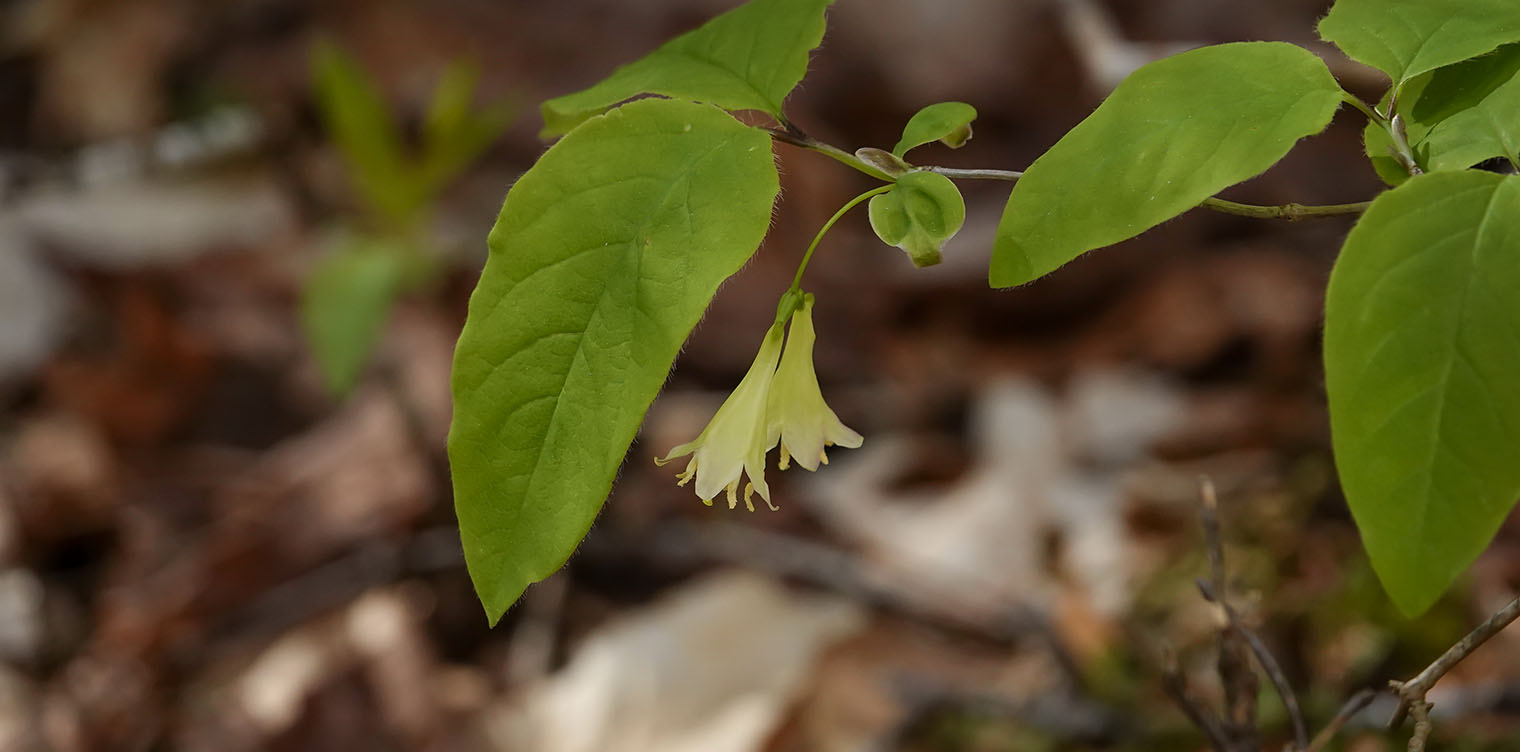
American Fly Honeysuckle (Lonicera canadensis) is a deciduous native shrub that bears paired yellowish flowers in May and small, bright red fruit in July.
American Fly Honeysuckle is a member of the Lonicera (Honeysuckle) genus. It is one of six native honeysuckles found in the Adirondack Park. The others are:
- Hairy Honeysuckle (Lonicera hirsuta)
- Mountain Fly Honeysuckle (Lonicera villosa)
- Smooth-leaved Honeysuckle (Lonicera dioica)
- Swamp Fly Honeysuckle (Lonicera oblongifolia)
- Trumpet Honeysuckle (Lonicera sempervirens)
The genus name (Lonicera) is a reference to Adam Lonitzer, a German naturalist who lived in the 16th century. Other nonscientific names for this species include: Fly Honeysuckle, Canada Honeysuckle, Canadian Fly Honeysuckle, Fly-honeysuckle, American Honeysuckle, American Fly-honeysuckle, and Early Fly Honeysuckle.
Identification of American Fly Honeysuckle
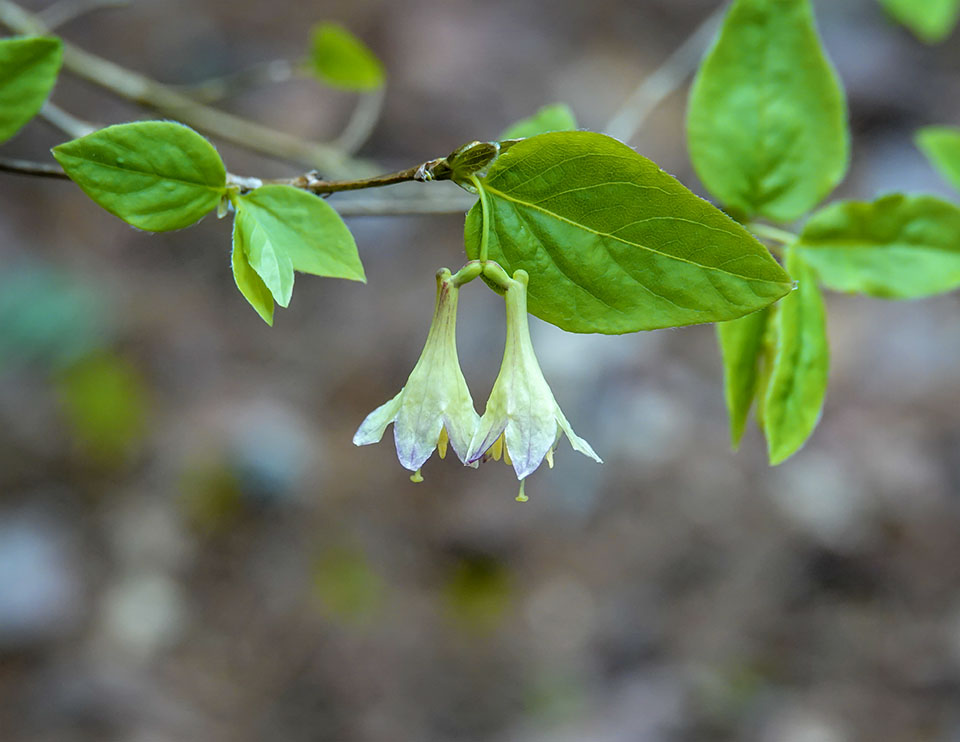
American Fly Honeysuckle is a deciduous shrub that grows from two to about four or five feet tall. It is loosely branched, with relatively sparse, flexible, and irregularly placed branches. Its main stems have light brown to brownish gray bark. The twigs are green to purplish.
The leaves of American Fly Honeysuckle are simple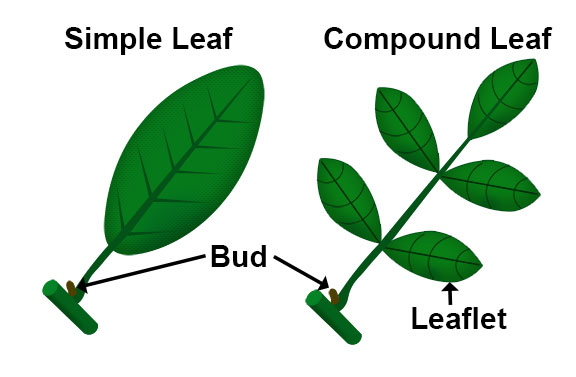 Simple Leaf: A leaf with a single undivided blade, as opposed to a compound leaf, which is one that is divided to the midrib, with distinct, expanded portions called leaflets., meaning that the leaves have a single, undivided blade, as opposed to a compound leaf which is divided into leaflets.
Simple Leaf: A leaf with a single undivided blade, as opposed to a compound leaf, which is one that is divided to the midrib, with distinct, expanded portions called leaflets., meaning that the leaves have a single, undivided blade, as opposed to a compound leaf which is divided into leaflets.
- The leaves of American Fly Honeysuckle are light green. They are 1½ to 3½ inches long and pointed at the tips.
- The leaves are opposite
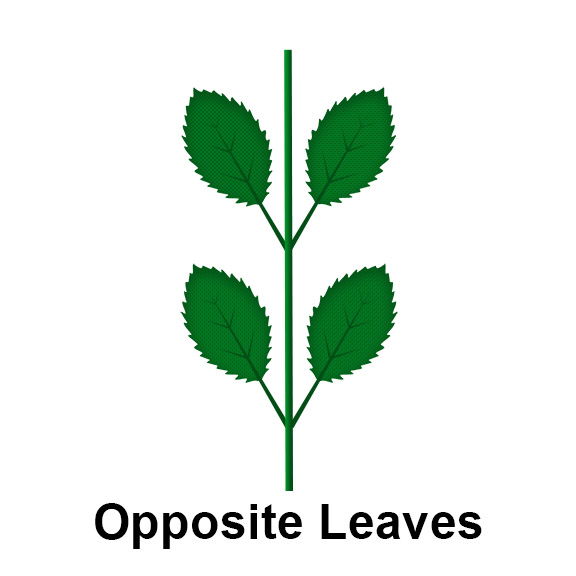 Opposite Leaves: Leaves occurring in pairs at a node, with one leaf on either side of the stem., meaning that they emerge from the twig in pairs, directly across from one another.
Opposite Leaves: Leaves occurring in pairs at a node, with one leaf on either side of the stem., meaning that they emerge from the twig in pairs, directly across from one another. - The marginsThe structure of the leaf's edge.
(edges) of the leaves are
smooth
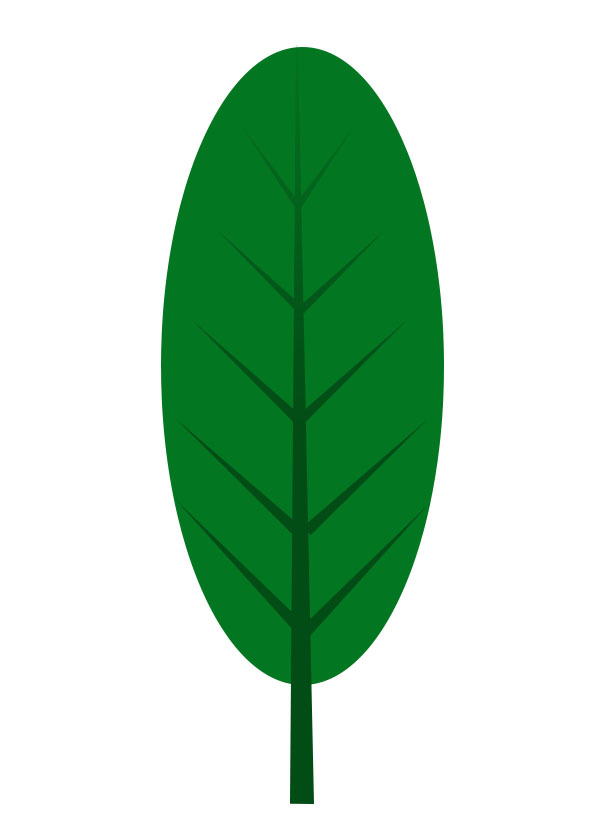 Smooth leaf edges do not have any teeth.
, meaning that the edge of the leaves do not have teeth. However, the leaves are ciliate, meaning that they are fringed with very fine hairs.
Smooth leaf edges do not have any teeth.
, meaning that the edge of the leaves do not have teeth. However, the leaves are ciliate, meaning that they are fringed with very fine hairs. - The upper surface of the leaves are hairless; the lower surface is somewhat paler than the upper.
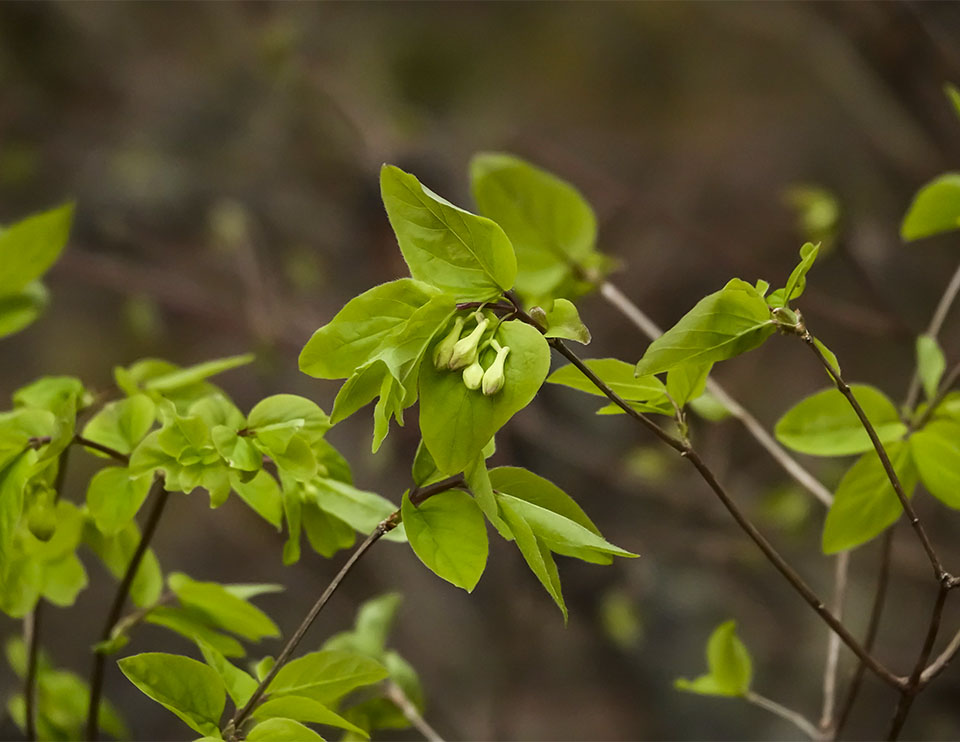
American Fly Honeysuckle produces pale yellow, tubular flowers in late spring. The flowers, which are ½ to ¾ inch long, tend to hang downward in pairs, emerging from the leaf axils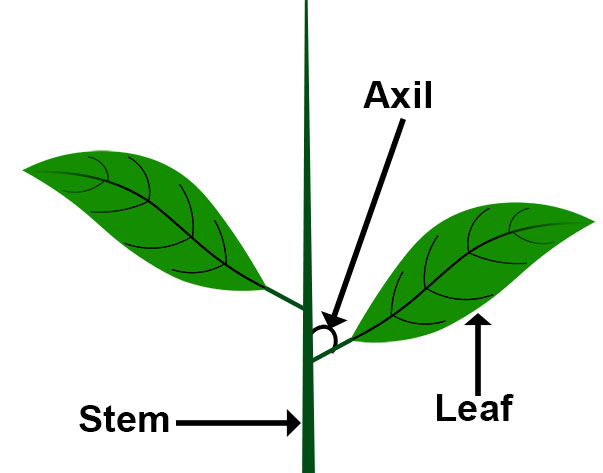 Axil: The angle between the upper side of a leaf or stem and the stem or branch that supports it. near the tips of one-year-old branches.
Axil: The angle between the upper side of a leaf or stem and the stem or branch that supports it. near the tips of one-year-old branches.
The flowers are tubular or funnel-shaped, with five triangular lobes. Five pale yellow stamens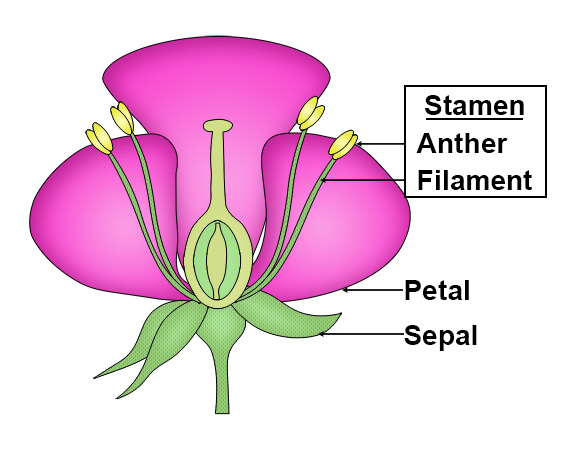 Stamen: The male part of the flower, made up of the filament and anther. and a long, slender yellow style
Stamen: The male part of the flower, made up of the filament and anther. and a long, slender yellow style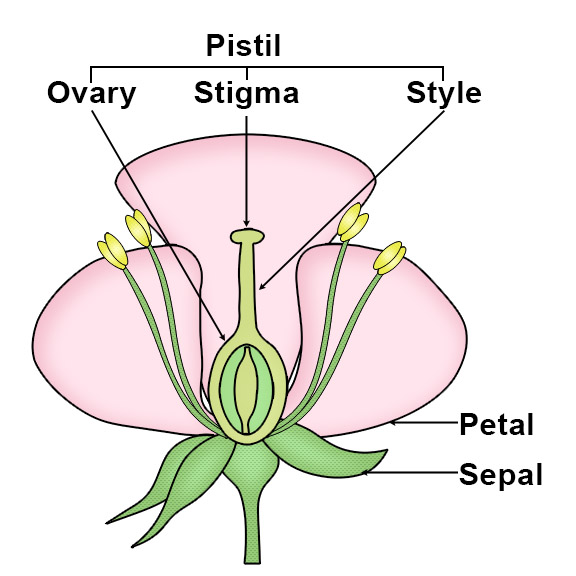 Style: The narrow, elongated part of the pistil between the ovary and the stigma. The style is part of the pistil (the female organs of a flower), which also consists of an ovary and a stigma. The style is the stalk that connects the stigma to the ovary. emerge from the tube. At the base of the tube, there is an asymmetrical swelling. The paired flowers are connected to the stalk by an oval, green ovary.
Style: The narrow, elongated part of the pistil between the ovary and the stigma. The style is part of the pistil (the female organs of a flower), which also consists of an ovary and a stigma. The style is the stalk that connects the stigma to the ovary. emerge from the tube. At the base of the tube, there is an asymmetrical swelling. The paired flowers are connected to the stalk by an oval, green ovary.
Throughout its range, American Fly Honeysuckle blooms from April to June. A tally of flowering dates for the upland Adirondack areas compiled by Michael Kudish, based on data collected from the early seventies to the early nineties, lists flowering dates from 7 May to 22 May. More recent data from the very limited number of observations in the Adirondack Park in the iNaturalist data base suggest a similar flowering pattern.
American Fly Honeysuckle's flowers are followed by fruit in the form of a pair of bright red, oval berries, suspended from the ends of long stalks. The egg-shaped berries are about ¼ inch long. They enclose several seeds. In the Adirondack region, the fruit ripens in very late June through early July.
Uses of American Fly Honeysuckle
American Fly Honeysuckle has limited medicinal uses, although it was used by several native American groups to treat various ailments. The Iroquois, for instance, used it as a blood purifier and sedative for children. The Menominee used the bark to treat urinary diseases. The Montagnais and Potawatomi used the species as a diuretic.
Wildlife Value of American Fly Honeysuckle
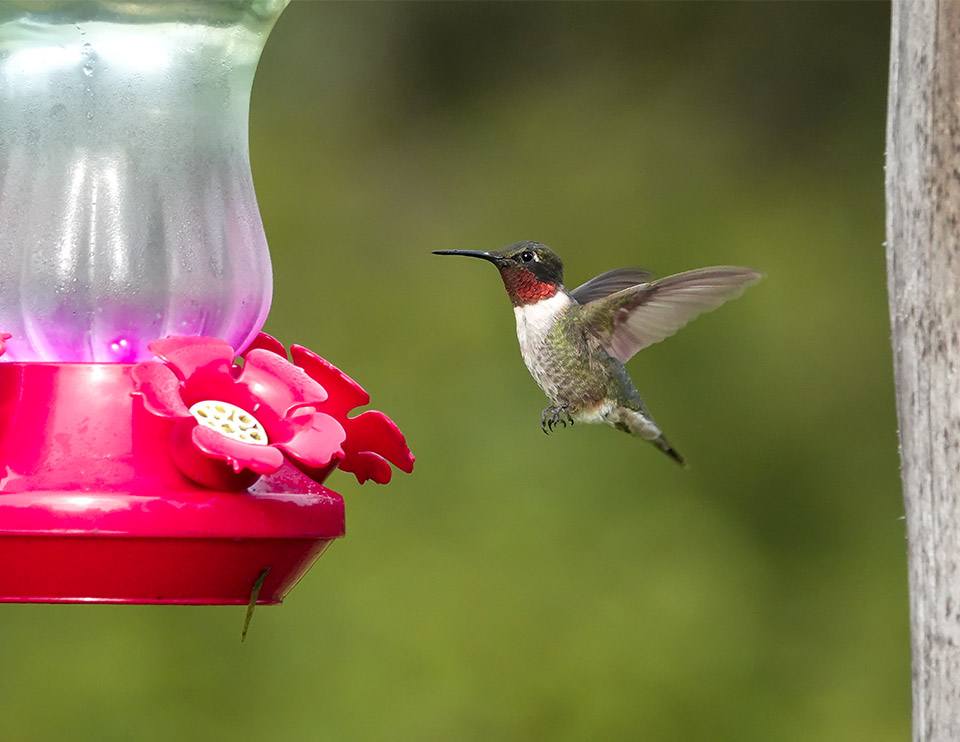
American Fly Honeysuckle has moderate wildlife value. The fruits of honeysuckle species are consumed by a wide variety of birds, including American Robins, American Goldfinch, and Gray Catbirds. Other birds, including Wild Turkey, Ruffed Grouse, and Dark-eyed Junco, use use honeysuckle species as cover.
Still other birds, including Northern Mockingbirds, Gray Catbirds, and Brown Thrashers, are known to use honeysuckle species as a nesting site. Ruby-throated Hummingbirds consume the nectar of American Fly Honeysuckle.
Distribution of American Fly Honeysuckle
American Fly Honeysuckle occurs is most of the southern Canadian provinces and northeastern US States, south to Virginia, Tennessee, and Georgia and west to Minnesota and Iowa. This plant is classified as extirpated in Indiana, endangered in Maryland and New Jersey, and a plant of special concern in Tennessee.
American Fly Honeysuckle is found throughout most of the eastern two-thirds of the State. Vouchered plant specimens have been recorded for all Adirondack Park Blue Line counties, except Clinton County.
Habitat of American Fly Honeysuckle
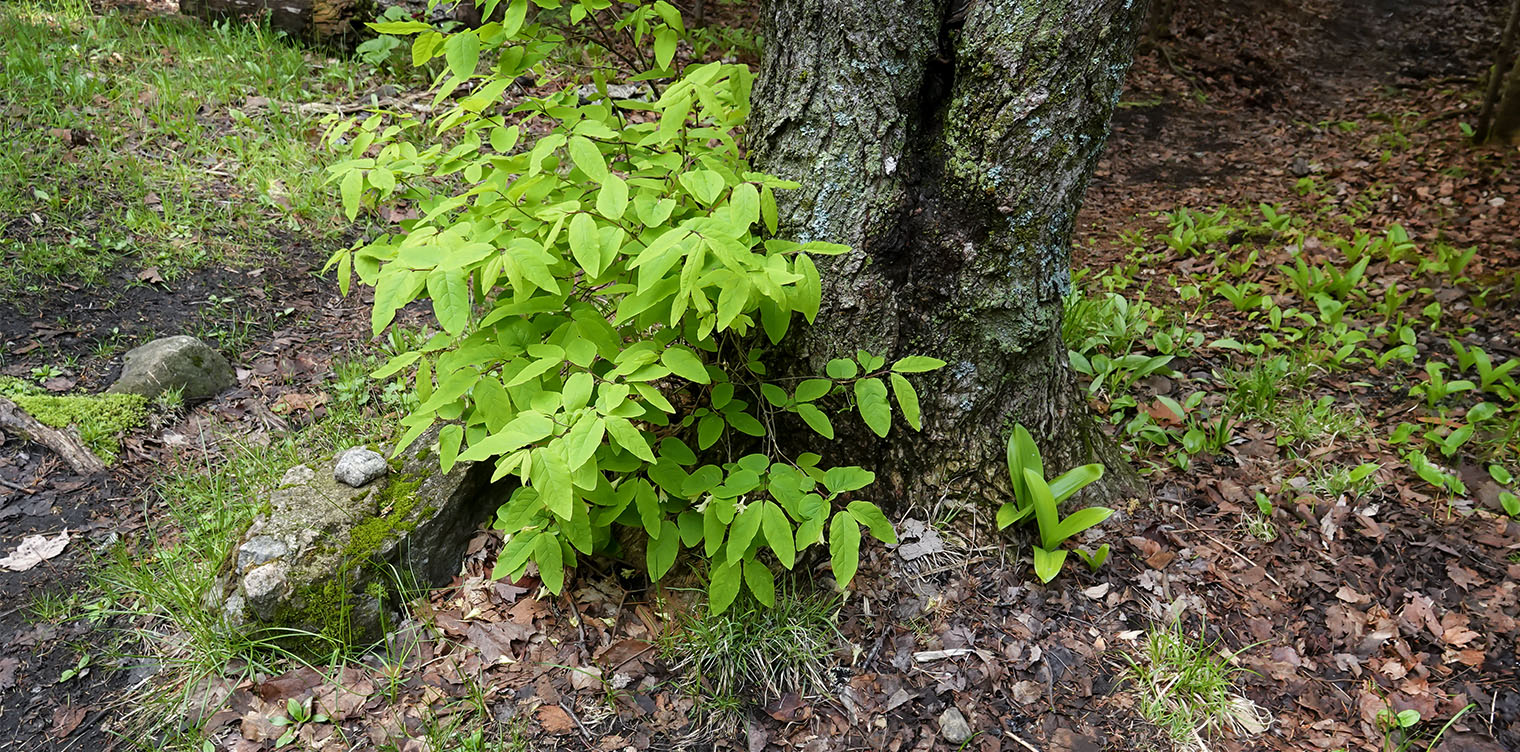
Throughout its range, American Fly Honeysuckle is classified as a Facultative Upland (FACU) plant, meaning that it usually occurs in non-wetlands, but may occur in wetlands. This plant is fairly flexible in terms of site requirements. It can tolerate shade or part shade and dry to moist sites. It is occasionally found in coniferous swamps or along streams.
In the Adirondacks, American Fly Honeysuckle is found in both hardwood stands and mixed forests. Adirondack ecological communities that host this species include spruce-northern hardwood forest and mountain spruce-fir forest. American Fly Honeysuckle usually occurs as isolated individual plants, rather than large colonies.
Among the trails covered here, American Fly Honeysuckle can be seen growing under hardwood trees in mixed forest on the Heart Lake Trail and the Boreal Life Trail. A few scattered plants are also found on the Jackrabbit Trail at River Road.
References
Michael Kudish. Adirondack Upland Flora: An Ecological Perspective (The Chauncy Press, 1992), p. 191.
New York Flora Association. New York Flora Atlas. Lonicera. Retrieved 20 March 2020.
New York Flora Association. New York Flora Atlas. American Fly Honeysuckle. Lonicera canadensis. Retrieved 20 March 2020.
Integrated Taxonomic Information System. Lonicera canadensis. Retrieved 20 March 2020.
United States Department of Agriculture. The Plants Database. American Fly Honeysuckle. Lonicera canadensis. Retrieved 20 March 2020.
United States Department of Agriculture. NRCS National Plant Data Center & the Biota of North America Program. Plant Fact Sheet. American Fly Honeysuckle. Lonicera canadensis. Retrieved 20 March 2020.
Northern Forest Atlas. Images. Canada Honeysuckle. Lonicera canadensis. Retrieved 20 March 2020.
Jerry Jenkins. Woody Plants of the Northern Forest. A Digital Atlas. (The Northern Forest Atlas Project, April 2020), p. 122. Retrieved 13 November 2021.
Margaret B. Gargiullo. A Guide to Native Plants of the New York City Region (New York City Department of Parks & Recreation, 2007), pp. 33-34.
Native Plant Trust. Go Botany. American Honeysuckle. Lonicera canadensis. Retrieved 20 March 2020.
New York State. Department of Environmental Conservation. New York Natural Heritage Program. Ecological Communities of New York State. Second Edition (March 2014), pp. 123-124. Retrieved 17 October 2015.
New York Natural Heritage Program. 2020. Online Conservation Guide for Mountain Spruce-Fir Forest. Retrieved 1 January 2020.
New York Natural Heritage Program. 2020. Online Conservation Guide for Spruce-Northern Hardwood Forest. Retrieved 1 January 2020.
New York State. Adirondack Park Agency. Preliminary List of Species Native Within the Adirondack Park Listed Alphabetically by Scientific Name and Sorted by Habit. Volume 1. Updated 10.23.2006, p. 10. Retrieved 26 January 2017.
Connecticut Botanical Society. Fly Honeysuckle. Lonicera canadensis. Retrieved 20 March 2020.
University of Wisconsin. Flora of Wisconsin. American fly honeysuckle. Lonicera canadensis. Retrieved 20 March 2020.
Minnesota Wildflowers. Fly Honeysuckle. Lonicera canadensis. Retrieved 20 March 2020.
Illinois Wildflowers. Vertebrate Animal & Plant Database. Lonicera spp. Retrieved 20 March 2020.
Illinois Wildflowers. Insect Visitors of Illinois Wildflowers. American Fly Honeysuckle. Lonicera canadensis. Retrieved 20 March 2020.
Illinois Wildflowers. Plant-Feeding Insect Database. Lonicera canadensis. Retrieved 20 March 2020.
New York State Department of Environmental Conservation. Winter Deer Foods. Retrieved 20 March 2020.
iNaturalist. American Fly-Honeysuckle. Lonicera canadensis. Retrieved 20 March 2020.
iNaturalist. Adirondack Park Observations. American Fly-Honeysuckle. Lonicera canadensis. Retrieved 20 March 2020.
William K. Chapman and Alan E. Bessette. Trees and Shrubs of the Adirondacks: A Field Guide (Utica, New York: North Country Books, 1990), p. 103, Plate 29.
James H. Soper and Margaret L. Heimburger. Shrubs of Ontario (Royal Ontario Museum, 1982), pp. 434-435. Retrieved 21 March 2020.
William Carey Grimm. The Illustrated Book of Wildflowers and Shrubs (Stackpole Books, 1993), pp. 580-581.
Gary Wade et al. Vascular Plant Species of the Forest Ecology Research and Demonstration Area, Paul Smiths, New York. USDA Forest Service. Research Note NE-380, p. 5. Retrieved 22 January 2017.
Mark J. Twery, et al. Changes in Abundance of Vascular Plants under Varying Silvicultural Systems at the Forest Ecosystem Research and Demonstration Area, Paul Smiths, New York. USDA Forest Service. Research Note NRS-169, p. 6. Retrieved 22 January 2017.
Alexander C. Martin, Herbert S. Zim, and Arnold L. Nelson. American Wildlife & Plants. A Guide to Wildlife Food Habits (Dover Publications, 1951), pp. 365-366. Retrieved 11 March 2020.
Richard M. DeGraaf. Trees, Shrubs, and Vines for Attracting Birds. Second Edition (University Press of New England, 2002), pp. 98-99. Retrieved 28 February 2020.
Plants for a Future. Lonicera canadensis. Retrieved 20 March 2020.
John Eastman. The Book of Forest and Thicket: Trees, Shrubs, and Wildflowers of Eastern North America (Stackpole Books, 1992), pp. 107-110.
University of Michigan. Native American Ethnobotany. A Database of Foods, Drugs, Dyes and Fibers of Native American Peoples, Derived from Plants. American Fly Honeysuckle. Lonicera canadensis. Retrieved 20 March 2020.
The Cornell Lab of Ornithology. Birds of the World. Subscription web site. Ruby-throated Hummingbird. Retrieved 20 March 2020.
Allen J. Coombes. Dictionary of Plant Names (Timber Press, 1994), p. 109.
Shrubs of the Adirondack Park
